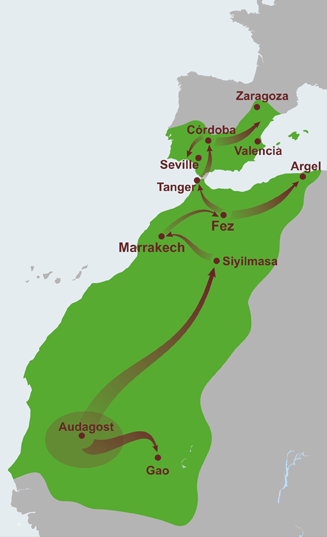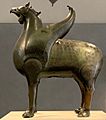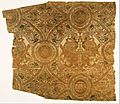Almoravid dynasty facts for kids
Quick facts for kids
Almoravid Empire
المرابطون
|
|||||||||||||||||||||||||||||||||||||
|---|---|---|---|---|---|---|---|---|---|---|---|---|---|---|---|---|---|---|---|---|---|---|---|---|---|---|---|---|---|---|---|---|---|---|---|---|---|
| 1040–1147 | |||||||||||||||||||||||||||||||||||||
|
Flag
|
|||||||||||||||||||||||||||||||||||||

Map showing the extent of the Almoravid empire
|
|||||||||||||||||||||||||||||||||||||
| Capital | Aghmat (1040-1062), Marrakech(1062-1147) & Córdoba | ||||||||||||||||||||||||||||||||||||
| Common languages | Berber languages (predominant), Classical Arabic, Mozarab, Hebrew language, African Romance & Andalusian Arabic | ||||||||||||||||||||||||||||||||||||
| Religion | Malikite Islam (predominant), Roman Catholic, Ibadi, Judaism & Sufism | ||||||||||||||||||||||||||||||||||||
| Government | Caliphate | ||||||||||||||||||||||||||||||||||||
| Caliph | |||||||||||||||||||||||||||||||||||||
|
• 1040-1059
|
Abdallah ibn Yasin | ||||||||||||||||||||||||||||||||||||
|
• 1146–1147
|
Ishaq ibn Ali | ||||||||||||||||||||||||||||||||||||
| History | |||||||||||||||||||||||||||||||||||||
|
• Established
|
1040 | ||||||||||||||||||||||||||||||||||||
|
• Disestablished
|
1147 | ||||||||||||||||||||||||||||||||||||
| Area | |||||||||||||||||||||||||||||||||||||
| 3,885,000 km2 (1,500,000 sq mi) | |||||||||||||||||||||||||||||||||||||
| Currency | Dinar & Maravedi | ||||||||||||||||||||||||||||||||||||
|
|||||||||||||||||||||||||||||||||||||
The Almoravids were a powerful group of Berber people from the Sahara desert. They created a large empire in the 11th century. This empire covered a huge part of North Africa and the Iberian Peninsula (modern-day Spain and Portugal).
At its biggest, the Almoravid empire included lands that are now Morocco, Western Sahara, Mauritania, and Gibraltar. It also stretched into parts of Algeria, Senegal, and Mali in Africa. In Europe, it included large parts of Spain and Portugal. This empire was incredibly vast, stretching about 3,000 kilometers from north to south!
Contents
Who Were the Almoravids?
The Almoravids started as a religious movement among the Lamtuna and Godala Berber tribes. These tribes lived in the western Sahara desert. Their leader was a religious scholar named Abdallah ibn Yasin. He taught a strict form of Islam.
In the 1040s, Abdallah ibn Yasin began to unite these tribes. They wanted to spread their beliefs and bring order to the region. They quickly grew into a strong military force.
Building an Empire
The Almoravids first took control of important trade routes in the Sahara. This helped them gain wealth and power. They then moved north into Morocco. They captured cities like Sijilmasa and Aghmat.
In 1062, they founded a new city called Marrakesh. This city became their capital and a major center of their empire. From Marrakesh, they continued to expand their rule.
Almoravid Leaders
The Almoravid Empire had several important leaders.
- Abdallah ibn Yasin (1040-1059): He was the founder and first leader. He inspired the movement.
- Yusuf ibn Tashfin (1061–1106): He was a great military leader. Under him, the empire grew to its largest size. He led the Almoravids into Spain.
- Ali ibn Yusuf (1106–42): He continued his father's work. He focused on building and strengthening the empire.
These leaders helped the Almoravids become a dominant power in their time.
The Almoravids in Spain
By the late 11th century, the Muslim rulers in Al-Andalus (Muslim Spain) were fighting among themselves. They were also losing land to Christian kingdoms in the north. They asked the Almoravids for help.
In 1086, Yusuf ibn Tashfin led his army across the Strait of Gibraltar. They defeated the Christian armies in the Battle of Sagrajas. This victory saved Muslim rule in Spain for a while.
After this, the Almoravids took control of most of Al-Andalus. They united the smaller Muslim states, called taifas, under their rule. They brought a period of stability to the region.
Life in the Almoravid Empire
The Almoravids were known for their strong religious beliefs. They built many mosques and religious schools. They also encouraged trade and learning.
Cities like Marrakesh and Córdoba became centers of culture and knowledge. People from different backgrounds, including Muslims, Christians, and Jews, lived in the empire.
The Almoravids used a currency called the Dinar. Their gold dinar coins were very important for trade. They even influenced the currency used in Europe.
Decline of the Empire
The Almoravid Empire began to weaken in the early 12th century. They faced challenges from within and outside their borders.
A new group called the Almohads rose in North Africa. They also had strong religious beliefs but were different from the Almoravids. The Almohads started to challenge Almoravid rule.
By 1147, the Almohads had taken over most of the Almoravid lands. This marked the end of the Almoravid Empire.
See Also
Images for kids
-
A 15th century depiction of the 11th century Almoravid general Abu Bakr ibn Umar ("Rex Bubecar") near the Senegal River in 1413 Majorcan chart. Abu Bakr was known for his conquests in Africa.
-
The Almoravid empire at its height stretched from the city of Aoudaghost to the Zaragoza in Al-Andalus
-
An Almoravid dinar coin from Seville, 1116. (British Museum); the Almoravid gold dinar would set the standard of the Iberian maravedí.
-
The Pisa Griffin, believed to have originated in 11th century Iberia.
-
A stele found at Gao-Saney believed to have been created in Almería during the Almoravid period. Now located at the National Museum of Mali.
-
Detail of the Almoravid minbar, commissioned by Ali Bin Yusuf Bin Tashfin al-Murabiti 1137 for his great mosque in Marrakesh.
-
A plaque at the burial place of the Poet King Al-Mu'tamid ibn Abbad, interred 1095 in Aghmat, Morocco.
-
The Almoravid Qubba in Marrakesh.
-
Interior of the Great Mosque of Tlemcen
-
Detail of the Almoravid-era bronze overlays on the doors of al-Qarawiyyin's Bab al-Gna'iz.
See also
 In Spanish: Almorávides para niños
In Spanish: Almorávides para niños
















